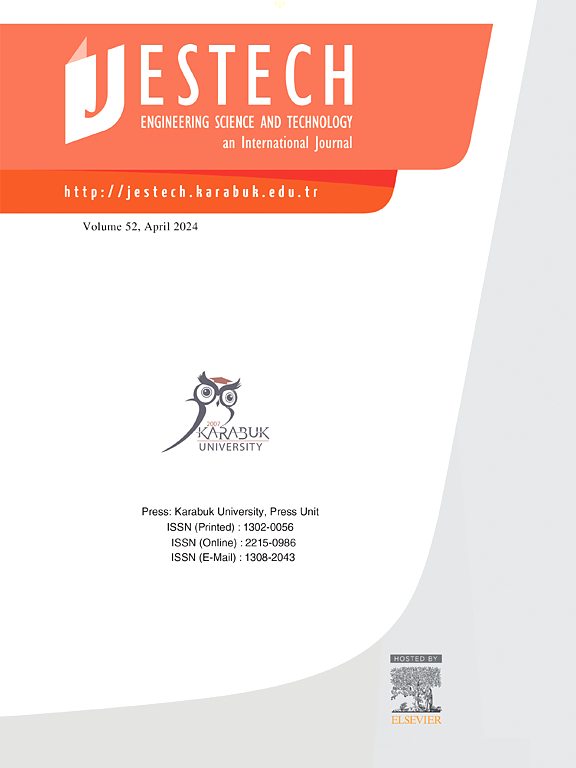Enhanced thermal management of lithium-ion batteries using hybrid nanofluids in finned mini-channels: Energy and entropy analyses
IF 5.4
2区 工程技术
Q1 ENGINEERING, MULTIDISCIPLINARY
Engineering Science and Technology-An International Journal-Jestech
Pub Date : 2025-04-26
DOI:10.1016/j.jestch.2025.102069
引用次数: 0
Abstract
Efficient thermal management is crucial for maintaining the safety and lifespan of battery packs, particularly during high-discharge operations. This study investigates an innovative approach to cooling these batteries by modifying traditional rectangular mini-channels with bio-inspired fins, modeled after dolphin dorsal shapes and fish contours. Unlike conventional cooling designs, these structures enhance fluid mixing and heat transfer efficiency when paired with a hybrid nanofluid (Fe3O4–SWCNT in water) under laminar flow conditions. A time-dependent numerical simulation was conducted to replicate unsteady heat generation in battery cells, and the results were validated against established studies. The findings indicated that dolphin dorsal fins and fish-shaped fins reduce total entropy generation by 28.59 % and 14.12 %, respectively, compared to a standard mini-channel. Additionally, the convective heat transfer coefficient improved by 20.18 % with dolphin fins and 43.04 % with fish fins, demonstrating superior thermal regulation. The hydrothermal performance, evaluated using the performance evaluation criterion (PEC), showed that the fish-shaped fins outperformed dolphin fins by 42.87 %, achieving a PEC value of 1.12. These results highlight the effectiveness of bio-inspired fin geometries in optimizing battery cooling systems, offering a promising strategy for improving the efficiency and longevity of batteries in electric vehicles.

利用混合纳米流体在鳍状微通道中增强锂离子电池的热管理:能量和熵分析
高效的热管理对于保持电池组的安全性和使用寿命至关重要,特别是在高放电操作期间。这项研究研究了一种创新的方法来冷却这些电池,通过修改传统的矩形微型通道与仿生鳍,模仿海豚的背部形状和鱼类的轮廓。与传统的冷却设计不同,在层流条件下,当与混合纳米流体(水中的fe3o4 - swcnts)配对时,这些结构增强了流体混合和传热效率。我们进行了一个时间相关的数值模拟来模拟电池的非定常热生成,并与已有的研究结果进行了验证。结果表明,海豚背鳍和鱼形鳍与标准小通道相比,分别减少了28.59%和14.12%的总熵产。此外,海豚鳍和鱼鳍的对流换热系数分别提高了20.18%和43.04%,显示出较好的热调节效果。采用性能评价标准(PEC)对鱼形鳍的热液性能进行评价,其性能优于海豚鳍42.87%,PEC值为1.12。这些结果突出了仿生翅片几何形状在优化电池冷却系统方面的有效性,为提高电动汽车电池的效率和寿命提供了一种有前途的策略。
本文章由计算机程序翻译,如有差异,请以英文原文为准。
求助全文
约1分钟内获得全文
求助全文
来源期刊

Engineering Science and Technology-An International Journal-Jestech
Materials Science-Electronic, Optical and Magnetic Materials
CiteScore
11.20
自引率
3.50%
发文量
153
审稿时长
22 days
期刊介绍:
Engineering Science and Technology, an International Journal (JESTECH) (formerly Technology), a peer-reviewed quarterly engineering journal, publishes both theoretical and experimental high quality papers of permanent interest, not previously published in journals, in the field of engineering and applied science which aims to promote the theory and practice of technology and engineering. In addition to peer-reviewed original research papers, the Editorial Board welcomes original research reports, state-of-the-art reviews and communications in the broadly defined field of engineering science and technology.
The scope of JESTECH includes a wide spectrum of subjects including:
-Electrical/Electronics and Computer Engineering (Biomedical Engineering and Instrumentation; Coding, Cryptography, and Information Protection; Communications, Networks, Mobile Computing and Distributed Systems; Compilers and Operating Systems; Computer Architecture, Parallel Processing, and Dependability; Computer Vision and Robotics; Control Theory; Electromagnetic Waves, Microwave Techniques and Antennas; Embedded Systems; Integrated Circuits, VLSI Design, Testing, and CAD; Microelectromechanical Systems; Microelectronics, and Electronic Devices and Circuits; Power, Energy and Energy Conversion Systems; Signal, Image, and Speech Processing)
-Mechanical and Civil Engineering (Automotive Technologies; Biomechanics; Construction Materials; Design and Manufacturing; Dynamics and Control; Energy Generation, Utilization, Conversion, and Storage; Fluid Mechanics and Hydraulics; Heat and Mass Transfer; Micro-Nano Sciences; Renewable and Sustainable Energy Technologies; Robotics and Mechatronics; Solid Mechanics and Structure; Thermal Sciences)
-Metallurgical and Materials Engineering (Advanced Materials Science; Biomaterials; Ceramic and Inorgnanic Materials; Electronic-Magnetic Materials; Energy and Environment; Materials Characterizastion; Metallurgy; Polymers and Nanocomposites)
 求助内容:
求助内容: 应助结果提醒方式:
应助结果提醒方式:


